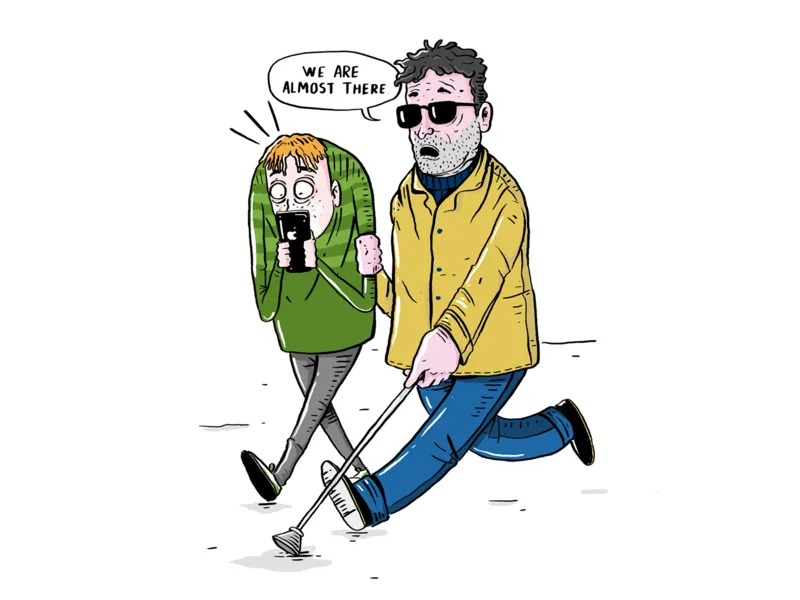Challenges blind people face when living life
What problems do the visually impaired encounter on a daily basis? Read on about six basic challenges explained in this article.
Having to deal with sight loss or low vision is merely one of the challenges that people who are blind or have low vision are facing when living life. Blind individuals are just like anyone else but they just can’t see. Is this case as simple in real life as in our minds, though? As one of Envision’s founders said in his TEDxGouda talk, we have built a world around us that serves the majority. That means that any individual different than the average, such as the visually impaired, faces difficulties because they’re not what is considered to be average. This article aims to shed light upon the challenges the blind and low vision community face just by living life and being the odd ones out.
Access to information: The major sensory organ of a person is their eyes. One glimpse around us is enough to make us realize how visual is most of the information in our environment. Timetables in train stations, signs indicating the right way or potential danger, a billboard advertising a new product in the market, these are all the visual types of information we all come across in our daily life. Most of this information is inaccessible for the blind and the visually impaired, inhibiting their independence, since access to information signifies autonomy. Consider downloading the free Envision app or check out our Envision Glasses, which offer a hands-free understanding and interaction with the world.
Overly helpful individuals: It’s very common for sighted individuals, strangers, friends or family, to be overly excited to help a visually impaired person. Very frequently, this behavior holds the assumption that the blind or low vision individual requires assistance, although this might not reflect reality. Blind people might perform a regular task slower but that doesn’t mean they’re incapable of completing it. Rushing to help the visually impaired without asking or being asked to do so, might make them feel helpless instead of independent. Moreover, not allowing a visually impaired individual perform a task by themselves, does not give them the room to learn how to do so independently.

Illustration by Jorge Martins
Societal stigma: Being blind in a world suited for the sighted, it means there will be multiple normal mishaps. Stumbling upon an office chair that wasn’t neatly tucked under the desk or knocking a glass off the table because it was left right on the edge, are small accidents that can happen and that’s okay. However, such mishaps tend to be perceived by sighted individuals as the inability of the visually impaired to perform tasks, while, in reality, they stem from the inaccessibility of our world. Blindness or low vision does not indicate the intelligence of the individual nor how sad their life is. Just because the sighted cannot imagine their world without vision does not mean that the visually impaired have a sad or unhappy life because of their visual condition.
Finding and keeping a job: Work is a whole different matter if you’re visually impaired. Considering the lack of accessible work and working spaces, one can already imagine why hiring a visually impaired individual would be considered a liability for a company. This has a negative impact on the confidence and emotional well-being of the visually impaired, while it totally cripples their economic independence. Having little to no opportunity to support oneself, blind or low vision individuals are incapacitated from their independence.
Leisure: The lack of accessibility for the visually impaired is central to a number of the issues the blind or low visual individuals face. Leisure is another one on the list. There is a limited number of inclusive/accessible activities for the visually impaired, which are as simple as a museum visit. Moreover, accessible books are not abundant either. According to the World Blind Union, “more than 90% of all published material is not accessible to the blind or partially sighted.” The internet, as in the new era we all surf the internet for fun, is not fully accessible either, since numerous websites disregard their visually impaired visitors and do not curate content that is accessible for the blind and low vision individuals. Considering these points and many more that are not listed here, one can clearly see how limited leisure options there are for the visually impaired.
Often living in isolation: Considering all of the above, it’s not a surprise that living with a visual impairment might signify, often, living in isolation. Dealing with sight loss, already, is a challenge in itself. The lack of emotional support at diagnosis centers, the limited accessibility to activities and information, the societal stigma and the lack of employment, are all factors frequently leading blind or low vision individuals in isolation. This last point illustrates how the problem for the visually impaired is not their blindness or lower vision in itself but their segregation from anyone else.
Are you or a loved one struggling with sight loss? Please, seek support in the following organizations or contact us here.
USA: AFB - American Foundation for the Blind
Canada: CNIB - Canadian National Institute for the Blind
Australia: Vision Australia & RSB - Royal Society for the Blind
UK: RNIB - Royal National Institute of Blind People
Ireland: NCBI - National Council for the Blind in Ireland
The Netherlands: Bartimeus & Visio
Belgium: Blindenzorg Licht en Liefde
Norway: Norges Blindeforbund
Denmark: Dansk Blindesamfund / Danish Association of the Blind







%201.svg)